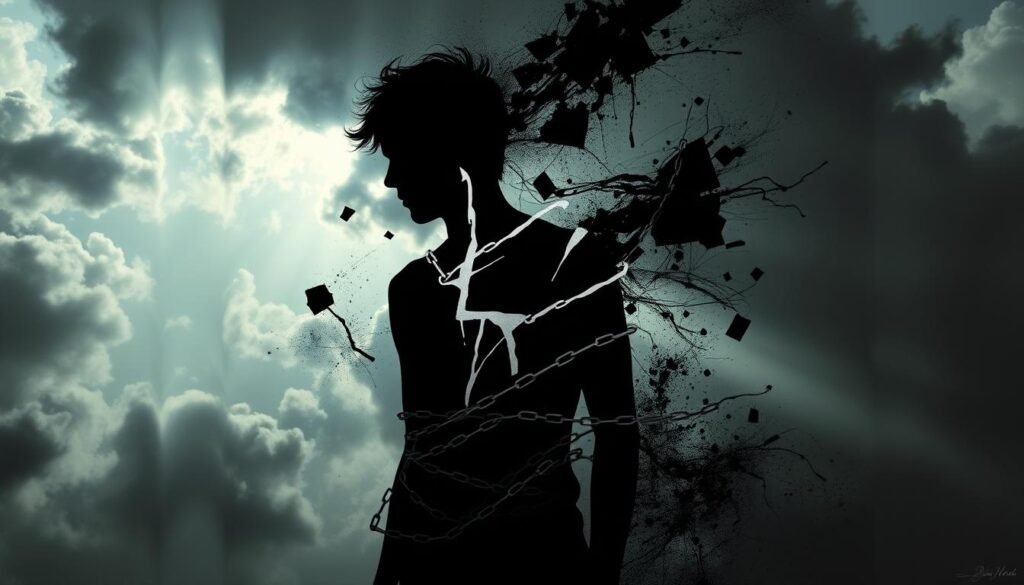Ever thought about what “pure mental harm” really is and how it affects our minds? In this detailed article, we’ll explore the world of psychological injuries. We’ll look at the medical views, how it’s different from other mental issues, and the signs of emotional pain. Knowing this can help us spot and help those suffering from this often-misunderstood problem.
What is pure mental harm, and how does it differ from other mental health issues? Grasping this complex topic is key to creating a more caring and supportive space for those in need. Let’s dive into the depths of pure mental harm and find the essential help for those who have faced this deep emotional pain.
Defining Pure Mental Harm and Its Impact on Mental Health
Pure mental harm, also known as psychic trauma or emotional distress, is a special kind of psychological injury. It’s different from other mental health issues because it’s caused by traumatic experiences. These can include abuse, neglect, or being intentionally made to feel emotional pain.
The Clinical Perspective of Psychological Injury
From a clinical view, pure mental harm is marked by deep and lasting mental pain. This can show up as depression, anxiety, PTSD, or even physical symptoms caused by mental stress. These wounds can deeply affect a person’s life, making it hard to function in daily tasks.
Distinguishing Pure Mental Harm from Other Mental Health Conditions
- Pure mental harm is not caused by biological or environmental factors like depression or anxiety. It’s caused by actions of others, whether intentional or not.
- The emotional trauma from pure mental harm is often more severe. It can deeply disrupt a person’s mental state and life.
- Healing from pure mental harm is harder. The person must deal with the symptoms and the traumatic event itself.
It’s important to understand pure mental harm to help those who have been through it. This way, we can offer the right support and help them heal.
Key Signs and Symptoms of Emotional Distress
Feeling emotional distress, mental suffering, or psychological injury can show up in many ways. It’s important to know the signs to get help quickly. Let’s look at some key indicators of pure mental harm.
One main sign of emotional distress is feeling anxious, worried, or tense all the time. People might find it hard to focus, feel restless, and have a constant feeling of unease. This can make everyday tasks hard to do.
Feeling sad all the time, losing interest in things you used to enjoy, and changes in sleep patterns are signs of depression. These can also mean you’re suffering from mental suffering due to psychological injury.
- Sudden mood swings or emotional outbursts
- Wanting to be alone and avoiding social interactions
- Having trouble controlling your emotions, leading to anger or feeling numb
- Having thoughts, flashbacks, or nightmares about the traumatic event
- Physical symptoms like headaches, muscle tension, or stomach problems
The signs and symptoms of emotional distress can differ from person to person. They can be affected by many things, like how severe the psychological injury is and how long you’ve been feeling this way. If you or someone you know is showing these signs, getting professional help is key. It’s important to address the issues and work towards healing and recovery.
The Psychology Behind Mental Anguish and Suffering
Understanding mental anguish and suffering needs a deep look into the mind. When people face intense emotional trauma, their thoughts and actions change a lot. These changes can be very deep and wide.
Cognitive Response to Emotional Trauma
The brain reacts in many ways to emotional trauma. People might have trouble focusing, feel anxious, and have intrusive thoughts. Their minds try to deal with the emotional pain.
This turmoil can cause problems like memory loss and poor decision-making. It makes the mental anguish worse.
Behavioral Changes During Mental Distress
People going through psychic trauma also change how they act. They might pull back from friends, start bad habits, or have trouble sleeping and eating. These emotional distress-caused changes make things harder.
It’s key to understand how thoughts and actions change with mental anguish. This helps us support people better. By seeing the full picture, we can help them heal and grow stronger.
Understanding Intentional Infliction of Emotional Distress
Some cases involve the intentional infliction of emotional distress. This happens when someone’s actions are meant to hurt another person’s mind. The law makes it hard to prove this, as it needs to show the person meant to cause harm.
Intentional emotional distress can take many forms. It can be constant harassment or making someone feel small. The person doing it wants to cause a lot of emotional pain.
- Examples of intentional infliction of emotional distress may include:
- Stalking or relentless verbal abuse
- Deliberately manipulating an individual’s emotions
- Exploiting a person’s fears or traumatic experiences
- Engaging in public humiliation or defamation
- Such actions can deeply affect a person’s mind. They might feel more anxious, depressed, or even get PTSD.
- People who suffer from intentional emotional distress might be able to get legal help. This depends on how bad the harm was.
It’s important to understand intentional infliction of emotional distress and its legal side. This helps deal with pure mental harm and psychological injury. By knowing the signs and getting help, people can protect their minds and fight for justice.
Recognizing Negligent Infliction of Pure Mental Harm
Mental suffering can be tricky to deal with legally. Unlike physical injuries, proving psychological injury or negligent infliction of emotional distress is harder. This part will look into the details of such claims and what evidence is needed.
Legal Aspects of Psychological Injury Claims
To win a case for negligent infliction of emotional distress, you must show the defendant’s actions caused your mental suffering. It’s a fine line, as the law wants clear proof of a strong emotional impact.
The rules for these claims differ by place, and courts check how severe the emotional distress was. It’s key to show a direct link between the defendant’s negligence and your mental harm.
Documentation Requirements for Mental Harm Cases
- Medical records: Detailed notes from mental health experts about your psychological injury and its effects.
- Witness statements: Statements from people close to you about how your behavior and mood have changed.
- Photographic/video evidence: Pictures or videos of your condition to support your mental suffering.
- Financial records: Records of any money lost or spent because of your psychological injury, like therapy or missed work.
Handling negligent infliction of emotional distress cases is complex. You need to know the laws well and collect strong evidence. Getting help from skilled lawyers is crucial for a strong case and getting justice for your mental suffering.
The Role of Professional Support in Mental Recovery
Starting the journey to mental well-being can feel overwhelming. But, with the help of professional support, people can find the tools they need. This support is crucial for overcoming emotional and mental challenges.
Getting help from mental health experts like therapists or psychologists is very helpful. They use different methods to help each person. This is because everyone’s needs and experiences are different.
- Cognitive-Behavioral Therapy (CBT) helps people change negative thought patterns and find better ways to cope.
- Dialectical Behavior Therapy (DBT) teaches skills to manage emotions and improve relationships.
- Psychodynamic Therapy looks at the unconscious reasons behind behavior, helping understand pure mind life challenges.
Working with a mental health professional creates a safe space for healing. It helps people build resilience and work towards a pure mind life. These experts provide strategies and care that fit each person’s needs.
With the support of mental health professionals, people can start a journey to pure mind life. They learn to manage their feelings and develop coping skills. This journey helps them find well-being again. The right support makes recovery easier, helping people take back their lives and thrive.
Coping Strategies for Managing Psychic Trauma
Dealing with psychic trauma or long-term mental pain is tough. But, there are ways to cope and heal. These strategies can help you find your way through this tough time.
Immediate Response Techniques
When you’re hit with sudden mental distress, having quick coping methods is key. These can include:
- Deep breathing exercises to calm your mind and body
- Grounding techniques to keep you in the present
- Mindfulness practices for better self-awareness and emotional control
- Seeking social support from loved ones or mental health experts
Long-term Management Methods
While quick fixes can help, dealing with deep trauma needs a bigger plan. Long-term strategies might include:
- Regular therapy to work through emotional scars and learn new coping skills
- Self-care through activities that boost your physical, emotional, and spiritual health
- Exploring creative outlets like writing, art, or music to express feelings
- Stress-reduction techniques like meditation, yoga, or exercise daily
Healing from psychic trauma or long-term mental pain is a journey. By using a whole-person approach and getting help when needed, you can manage your mental health over time.
Building Resilience Against Mental Suffering
Building resilience is key to dealing with mental suffering and emotional distress. It helps people handle and bounce back from mental harm. This section will look at ways to build mental strength and live a healthier life despite psychological challenges.
Being positive and focused on solutions is a big part of resilience. When emotions get tough, being thankful, mindful, and changing negative thoughts can help. Stress-reducing activities like meditation or deep breathing can also improve emotional health.
Having a strong support network is also vital. Friends, family, or mental health experts can offer much-needed support and encouragement. Talking openly about mental struggles and seeking help can lead to healing and growth.



